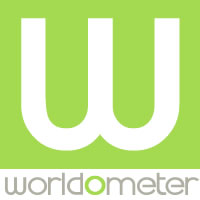COVID-19: India may be nearing an inflection point
Keeping in mind that it is very difficult to make accurate predictions of future epidemic behaviour at best, that what I'm doing here is pretty much strictly chart-reading (rather than looking at fundamentals), and that I'm an armchair analyst here...
It looks as if India might be reaching an inflection point in its recent explosion of COVID-19 cases. The past several day' data seem to be trending at a slightly longer doubling rate. This based on eyeball assessments and spot checks from Worldometer's COVID page.
Note that data are NOISY, that there's a lot of short-term variance, and that real trends often take a few weeks to be clear. Listing out the arguments for and against an inflection:
- Looking at current-vs-seven-days-prior data shows a below-trend deviation in data for 25 April, and today's counts (the 26th) seem to be likewise trending low. Current numbers (not yet finalised) are for 319k new cases, down from 354k yesterday. Late-in-the-day values tend to be close to the final, and that's a very large deficit to make up, so I'm reasonably confident.
- This could be pointing to a mid-point inflection (or an inflection already underway. The peak daily case rate might be anywhere from ~400k -- 600k cases, but would likely be well below the 1 million mark I'd mentioned a few days ago.
- Changes in spread rate tend to appear about two weeks after stricter containment efforts, and India began tightening its lockdown measures about two weeks ago. (More on this below.)
- India doesn't seem to substantially revise its data upwards, so the actual close-of-day numbers may be durable, rather than subject to significant later revision. (Sweden is notably prone to this, as I've discussed before.)
The con arguments are:
- India's case rise has been so large and fast that it may simply be that detection capabilities are limiting new counts, whether by overwhelmed hospitals, labs, transport, or other means.
- Numbers may be revised upwards later.
- The apparent shift could simply be noise in the data --- variance in behaviour, weekend lags in diagnosis or detection, or the like.
It is very early to be making this call, though the possibility exists.
I noted the response lag above. One of the key factors to understand with epidemics is that due to the infectious and exponential nature of new cases, as well as detection lags, it takes significant time to detect new directions. And in that time, conditions can change massively. For those who've been arguing that reactions to COVID-19 have been excessive, recognise that India saw new daily case rates increase by more than 30-fold since late February. In the case of Thailand, another country with rapidly growing cases, a similar increase occurred in three weeks, rather than six as with India. So long as the virus is circulating, and mutating, conditions can change very quickly and with huge shifts in behaviour (infectiousness, severity, affected demographics).
The lag between a change in policy and epidemic behaviour is at least two weeks. And the initial signs are very slight. Exponential growth doesn't mean "fast", it means "imperceptable for a long time, then suddenly overwhelming". The first weeks of India's current wave were very hard to see. Inflections are also hard to spot as they occur.
But, again, possible good news, stay tuned.
And keep practicing safe behaviours: Stay at home, wear a mask when out, wash your hands, and get a vaccination if you can.
